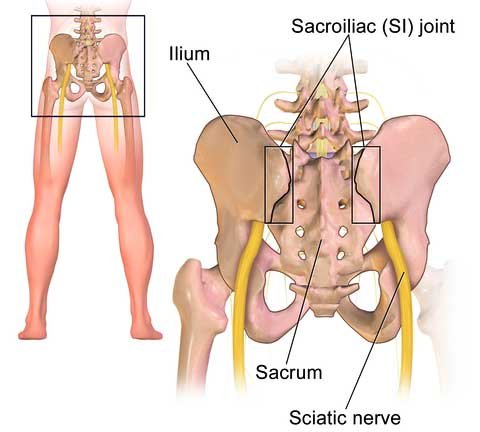 The sacroiliac joint is the joint between the bones of the pelvis and the lower part of the vertebral column known as the sacrum. It is the largest and strongest joint in the body. There is no much movement occurring in this joint as there are strong ligaments holding the bones together.
The sacroiliac joint is the joint between the bones of the pelvis and the lower part of the vertebral column known as the sacrum. It is the largest and strongest joint in the body. There is no much movement occurring in this joint as there are strong ligaments holding the bones together.
Also, a group of strong muscles take origin from the region of the joint adding to its stability.
Sacroiliitis pain occurs usually in the buttocks and lower back. It can also affect the legs and groin. Pain can be aggravated by:
- Running
- Prolonged standing
- Stair climbing
- Putting more weight on one leg
- Taking large strides
Sacroiliac pain may be due to causes inside the joint (intra-articular) or outside of the joint (extra-articular).
Intra-articular causes include:
- Arthritis
- Trauma
- Infection
- Spondyloarthropathy
Extra-articular sources include:
- Ligamentous injury
- Myofascial pain
- Pregnancy
- Trauma/fractures
In extra-articular causes, there is usually pain on palpating the joint and pain is usually one-sided. Sacroiliac joint symptoms can mimic other common back conditions e,g bulging disc. Sometimes a local injection of an anesthetic drug into the joint is used to confirm the diagnosis.
Treatment:
Non surgical:
The vast majority of patients with sacroiliac pain are treated without surgery. This includes:
- Rest: to help reduce the pain and inflammation
- Heat: to improve the blood flow to the area of the joint.
- Ice: may be used in cases of acute attacks to reduce the inflammation.
- Sleeping position: it is preferred that the patient sleeps on his side with a pillow placed between the knees.
- Medicines: non-steroidal anti-inflammatory drugs e.g. ibuprofen helps relieve the pain and reduce the inflammation.
- Intra-articular cortisone injection: may be indicated in severe cases not responding to other modes of treatment.
- Physiotherapy and exercises
Surgery:
In severe cases that were not relieved by other methods, surgery may be done as a last resort. During this surgery, the cartilage is removed from the joint and the two bones are fused together so that no pain or motion will occur in the joint.

